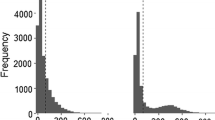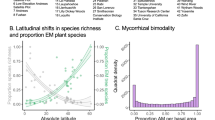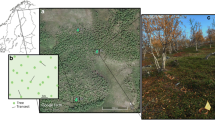Abstract
Forest dynamics are shaped by both abiotic and biotic factors. Trees associating with different types of mycorrhizal fungi differ in nutrient use and dominate in contrasting environments, but it remains unclear whether they exhibit differential growth responses to local abiotic and biotic gradients where they co-occur. We used 9-year tree census data in a 25-ha old-growth temperate forest in Northeast China to examine differences in tree growth response to soil nutrients and neighborhood crowding between tree species associating with arbuscular mycorrhizal (AM), ectomycorrhizal (EM), and dual-mycorrhizal (AEM) fungi. In addition, we tested the role of individual-level vs species-level leaf traits in capturing differences in tree growth response to soil nutrients and neighborhood crowding across mycorrhizal types. Across 25 species, soil nutrients decreased AM tree growth, while neighborhood crowding reduced both AM and EM tree growth, and neither soil nor neighbors impacted AEM tree growth. Across mycorrhizal types, individual-level traits were stronger predictors of tree growth than species-level traits. However, most traits poorly mediated tree growth response to soil nutrients and neighborhood crowding. Our findings indicate that mycorrhizal types strongly shape differences in tree growth response to local soil and crowding gradients, and suggest that including plant-mycorrhizae associations in future work offers great potential to improve our understanding of forest dynamics.



Similar content being viewed by others
Data availability
Data are available upon reasonable request to ZQH.
References
Anderegg LDL, HilleRisLambers J (2016) Drought stress limits the geographic ranges of two tree species via different physiological mechanisms. Glob Change Biol 22:1029–1045. https://doi.org/10.1111/gcb.13148
Auger S, Shipley B (2013) Inter-specific and intra-specific trait variation along short environmental gradients in an old-growth temperate forest. J Veg Sci 24:419–428. https://doi.org/10.1111/j.1654-1103.2012.01473.x
Averill C, Bhatnagar JM, Dietze MC, Pearse WD, Kivlin SN (2019) Global imprint of mycorrhizal fungi on whole-plant nutrient economics. Proc Natl Acad Sci 116:23163. https://doi.org/10.1073/pnas.1906655116
Barceló M, van Bodegom PM, Soudzilovskaia NA (2019) Climate drives the spatial distribution of mycorrhizal host plants in terrestrial ecosystems. J Ecol 107:2564–2573. https://doi.org/10.1111/1365-2745.13275
Bennett JA, Maherali H, Reinhart KO, Lekberg Y, Hart MM, Klironomos J (2017) Plant-soil feedbacks and mycorrhizal type influence temperate forest population dynamics. Science 355:181–184. https://doi.org/10.1126/science.aai8212
Bonan GB (2008) Forests and climate change: forcings, feedbacks, and the climate benefits of forests. Science 320:1444–1449. https://doi.org/10.1126/science.1155121
Brown AJ, Payne CJ, White PS, Peet RK (2020) Shade tolerance and mycorrhizal type may influence sapling susceptibility to conspecific negative density dependence. J Ecol 108:325–336. https://doi.org/10.1111/1365-2745.13237
Brundrett MC (2009) Mycorrhizal associations and other means of nutrition of vascular plants: understanding the global diversity of host plants by resolving conflicting information and developing reliable means of diagnosis. Plant Soil 320:37–77. https://doi.org/10.1007/s11104-008-9877-9
Bueno CG et al (2017) Plant mycorrhizal status, but not type, shifts with latitude and elevation in Europe. Glob Ecol Biogeogr 26:690–699. https://doi.org/10.1111/geb.12582
Canham CD, Papaik MJ, Uriarte M, McWilliams WH, Jenkins JC, Twery MJ (2006) Neighborhood analyses of canopy tree competition along environmental gradients in new england forests. Ecol Appl 16:540–554. https://doi.org/10.1890/1051-0761(2006)016[0540:Naoctc]2.0.Co;2
Chen W, Koide RT, Adams TS, DeForest JL, Cheng L, Eissenstat DM (2016) Root morphology and mycorrhizal symbioses together shape nutrient foraging strategies of temperate trees. Proc Natl Acad Sci 113:8741. https://doi.org/10.1073/pnas.1601006113
Chen W, Koide RT, Eissenstat DM (2018) Nutrient foraging by mycorrhizas: from species functional traits to ecosystem processes. Funct Ecol 32:858–869. https://doi.org/10.1111/1365-2435.13041
Chen L et al (2019) Differential soil fungus accumulation and density dependence of trees in a subtropical forest. Science 366:124–128. https://doi.org/10.1126/science.aau1361
Clark DA, Clark DB (1999) Assessing the growth of tropical rain forest trees: issues for forest modeling and management. Ecol Appl 9:981–997. https://doi.org/10.1890/1051-0761(1999)009[0981:ATGOTR]2.0.CO;2
Clark DA, Piper SC, Keeling CD, Clark DB (2003) Tropical rain forest tree growth and atmospheric carbon dynamics linked to interannual temperature variation during 1984–2000. Proc Natl Acad Sci 100:5852–5857. https://doi.org/10.1073/pnas.0935903100
Coates KD, Lilles EB, Astrup R (2013) Competitive interactions across a soil fertility gradient in a multispecies forest. J Ecol 101:806–818. https://doi.org/10.1111/1365-2745.12072
Cornelissen JHC et al (2003) A handbook of protocols for standardised and easy measurement of plant functional traits worldwide. Aust J Bot 51:335–380. https://doi.org/10.1071/Bt02124
Coughlan AP, Dalpé Y, Lapointe L, Piché Y (2000) Soil pH-induced changes in root colonization, diversity, and reproduction of symbiotic arbuscular mycorrhizal fungi from healthy and declining maple forests. Can J for Res 30:1543–1554. https://doi.org/10.1139/x00-090
Courty P-E et al (2010) The role of ectomycorrhizal communities in forest ecosystem processes: New perspectives and emerging concepts. Soil Biol Biochem 42:679–698. https://doi.org/10.1016/j.soilbio.2009.12.006
Curzon MT, D’Amato AW, Fraver S, Huff ES, Palik BJ (2017) Succession, climate and neighbourhood dynamics influence tree growth over time: an 87-year record of change in a Pinus resinosa-dominated forest, Minnesota, USA. J Veg Sci 28:82–92. https://doi.org/10.1111/jvs.12471
DeForest JL, Snell RS (2020) Tree growth response to shifting soil nutrient economy depends on mycorrhizal associations. New Phytol 225:2557–2566. https://doi.org/10.1111/nph.16299
Díaz S et al (2016) The global spectrum of plant form and function. Nature 529:167–171. https://doi.org/10.1038/nature16489
Duchesne LC, Peterson RL, Ellis BE (1988) Interaction between the ectomycorrhizal fungus Paxillus involutus and Pinus resinosa induces resistance to Fusarium oxysporum. Can J Bot 66:558–562. https://doi.org/10.1139/b88-080
Eissenstat DM (1992) Costs and benefits of constructing roots of small diameter. J Plant Nutr 15:763–782. https://doi.org/10.1080/01904169209364361
Elser JJ et al (2007) Global analysis of nitrogen and phosphorus limitation of primary producers in freshwater, marine and terrestrial ecosystems. Ecol Lett 10:1135–1142. https://doi.org/10.1111/j.1461-0248.2007.01113.x
Erel R, Yermiyahu U, Ben-Gal A, Dag A, Shapira O, Schwartz A (2015) Modification of non-stomatal limitation and photoprotection due to K and Na nutrition of olive trees. J Plant Physiol 177:1–10. https://doi.org/10.1016/j.jplph.2015.01.005
Fang S et al (2019) Deterministic processes drive functional and phylogenetic temporal changes of woody species in temperate forests in Northeast China. Ann for Sci 76:42. https://doi.org/10.1007/s13595-019-0830-2
Farquhar GD, O’Leary MH, Berry JA (1982) On the relationship between carbon isotope discrimination and the intercellular carbon dioxide concentration in leaves. Funct Plant Biol 9:121–137. https://doi.org/10.1071/PP9820121
Fortunel C, Valencia R, Wright SJ, Garwood NC, Kraft NJB (2016) Functional trait differences influence neighbourhood interactions in a hyperdiverse Amazonian forest. Ecol Lett 19:1062–1070. https://doi.org/10.1111/ele.12642
Fortunel C et al (2018) Topography and neighborhood crowding can interact to shape species growth and distribution in a diverse Amazonian forest. Ecology 99:2272–2283. https://doi.org/10.1002/ecy.2441
Gitelson AA, Gritz Y, Merzlyak MN (2003) Relationships between leaf chlorophyll content and spectral reflectance and algorithms for non-destructive chlorophyll assessment in higher plant leaves. J Plant Physiol 160:271–282. https://doi.org/10.1078/0176-1617-00887
Givnish TJ (1987) Comparative studies of leaf form: assessing the relative roles of selective pressures and phylogenetic constraints. New Phytol 106:131–160. https://doi.org/10.1111/j.1469-8137.1987.tb04687.x
Guo D, Xia M, Wei X, Chang W, Liu Y, Wang Z (2008) Anatomical traits associated with absorption and mycorrhizal colonization are linked to root branch order in twenty-three Chinese temperate tree species. New Phytol 180:673–683. https://doi.org/10.1111/j.1469-8137.2008.02573.x
Hodge A, Fitter AH (2010) Substantial nitrogen acquisition by arbuscular mycorrhizal fungi from organic material has implications for N cycling. Proc Natl Acad Sci 107:13754–13759. https://doi.org/10.1073/pnas.1005874107
Jiang F, Zhu K, Cadotte MW, Jin G (2020) Tree mycorrhizal type mediates the strength of negative density dependence in temperate forests. J Ecol 108:2601–2610. https://doi.org/10.1111/1365-2745.13413
Jo I, Fei S, Oswalt CM, Domke GM, Phillips RP (2019) Shifts in dominant tree mycorrhizal associations in response to anthropogenic impacts. Sci Adv. https://doi.org/10.1126/sciadv.aav6358
Johnson DJ et al (2018) Climate sensitive size-dependent survival in tropical trees. Nat Ecol Evol 2:1436–1442. https://doi.org/10.1038/s41559-018-0626-z
Kunstler G et al (2016) Plant functional traits have globally consistent effects on competition. Nature 529:204–207. https://doi.org/10.1038/nature16476
Laliberté E, Lambers H, Burgess TI, Wright SJ (2015) Phosphorus limitation, soil-borne pathogens and the coexistence of plant species in hyperdiverse forests and shrublands. New Phytol 206:507–521. https://doi.org/10.1111/nph.13203
Lambers H, Raven JA, Shaver GR, Smith SE (2008) Plant nutrient-acquisition strategies change with soil age. Trends Ecol Evol 23:95–103. https://doi.org/10.1016/j.tree.2007.10.008
Lasky JR, Sun IF, Su S-H, Chen Z-S, Keitt TH (2013) Trait-mediated effects of environmental filtering on tree community dynamics. J Ecol 101:722–733. https://doi.org/10.1111/1365-2745.12065
Lasky JR, Yang J, Zhang G, Cao M, Tang Y, Keitt TH (2014) The role of functional traits and individual variation in the co-occurrence of Ficus species. Ecology 95:978–990. https://doi.org/10.1890/13-0437.1
Li Y, Tian D, Yang H, Niu S (2018) Size-dependent nutrient limitation of tree growth from subtropical to cold temperate forests. Funct Ecol 32:95–105. https://doi.org/10.1111/1365-2435.12975
Liang M, Liu X, Etienne RS, Huang F, Wang Y, Yu S (2015) Arbuscular mycorrhizal fungi counteract the Janzen-Connell effect of soil pathogens. Ecology 96:562–574. https://doi.org/10.1890/14-0871.1
Lin G, McCormack ML, Guo D, Phillips R (2015) Arbuscular mycorrhizal fungal effects on plant competition and community structure. J Ecol 103:1224–1232. https://doi.org/10.1111/1365-2745.12429
Lindahl BD, Tunlid A (2015) Ectomycorrhizal fungi—potential organic matter decomposers, yet not saprotrophs. New Phytol 205:1443–1447. https://doi.org/10.1111/nph.13201
Liu X et al (2016) Linking individual-level functional traits to tree growth in a subtropical forest. Ecology 97:2396–2405. https://doi.org/10.1002/ecy.1445
Liu X et al (2018) Partitioning of soil phosphorus among arbuscular and ectomycorrhizal trees in tropical and subtropical forests. Ecol Lett 21:713–723. https://doi.org/10.1111/ele.12939
Long W, Zang R, Schamp BS, Ding Y (2011) Within- and among-species variation in specific leaf area drive community assembly in a tropical cloud forest. Oecologia 167:1103–1113. https://doi.org/10.1007/s00442-011-2050-9
Ma X et al (2021) Global negative effects of nutrient enrichment on arbuscular mycorrhizal fungi, plant diversity and ecosystem multifunctionality. New Phytol 229:2957–2969. https://doi.org/10.1111/nph.17077
Marx DH (1972) Ectomycorrhizae as biological deterrents to pathogenic root infections. Annu Rev Phytopathol 10:429–454. https://doi.org/10.1146/annurev.py.10.090172.002241
McGregor IR et al (2021) Tree height and leaf drought tolerance traits shape growth responses across droughts in a temperate broadleaf forest. New Phytol 231:601–616. https://doi.org/10.1111/nph.16996
Miller HG (1981) Forest fertilization: some guiding concepts. Forestry 54:157–167. https://doi.org/10.1093/forestry/54.2.157
Paine CET et al (2015) Globally, functional traits are weak predictors of juvenile tree growth, and we do not know why. J Ecol 103:978–989. https://doi.org/10.1111/1365-2745.12401
Pérez-Harguindeguy N et al (2013) New handbook for standardised measurement of plant functional traits worldwide. Aust J Bot 61:167–234. https://doi.org/10.1071/BT12225
Phillips RP, Brzostek E, Midgley MG (2013) The mycorrhizal-associated nutrient economy: a new framework for predicting carbon–nutrient couplings in temperate forests. New Phytol 199:41–51. https://doi.org/10.1111/nph.12221
Plassard C, Dell B (2010) Phosphorus nutrition of mycorrhizal trees. Tree Physiol 30:1129–1139. https://doi.org/10.1093/treephys/tpq063
Poorter L, Bongers F (2006) Leaf traits are good predictors of plant performance across 53 rain forest species. Ecology 87:1733–1743. https://doi.org/10.1890/0012-9658(2006)87[1733:LTAGPO]2.0.CO;2
Poorter L et al (2008) Are functional traits good predictors of demographic rates? Evidence from five neotropical forests. Ecology 89:1908–1920. https://doi.org/10.1890/07-0207.1
Püschel D, Janoušková M, Hujslová M, Slavíková R, Gryndlerová H, Jansa J (2016) Plant-fungus competition for nitrogen erases mycorrhizal growth benefits of Andropogon gerardii under limited nitrogen supply. Ecol Evol 6:4332–4346. https://doi.org/10.1002/ece3.2207
Reich PB, Oleksyn J (2004) Global patterns of plant leaf N and P in relation to temperature and latitude. Proc Natl Acad Sci 101:11001–11006. https://doi.org/10.1073/pnas.0403588101
Ruiz-Benito P et al (2017) Functional diversity underlies demographic responses to environmental variation in European forests. Glob Ecol Biogeogr 26:128–141. https://doi.org/10.1111/geb.12515
Silvertown J (2004) Plant coexistence and the niche. Trends Ecol Evol 19:605–611. https://doi.org/10.1016/j.tree.2004.09.003
Smith SE, Read DJ (2008) Mycorrhizal symbiosis, 3rd edn. Academic Press, London, UK
Soudzilovskaia NA et al (2015) Global patterns of plant root colonization intensity by mycorrhizal fungi explained by climate and soil chemistry. Glob Ecol Biogeogr 24:371–382. https://doi.org/10.1111/geb.12272
Soudzilovskaia NA et al (2020) FungalRoot: global online database of plant mycorrhizal associations. New Phytol 227:955–966. https://doi.org/10.1111/nph.16569
Steidinger BS et al (2019) Climatic controls of decomposition drive the global biogeography of forest-tree symbioses. Nature 569:404–408. https://doi.org/10.1038/s41586-019-1128-0
Su Y-S, Yajima M (2015) R2jags: a package for running jags from R. R package version 0.05-01
Tedersoo L, Bahram M, Zobel M (2020) How mycorrhizal associations drive plant population and community biology. Science. https://doi.org/10.1126/science.aba1223
Teste FP et al (2017) Plant–soil feedback and the maintenance of diversity in Mediterranean-climate shrublands. Science 355:173–176. https://doi.org/10.1126/science.aai8291
Teste FP, Jones MD, Dickie IA (2020) Dual-mycorrhizal plants: their ecology and relevance. New Phytol 225:1835–1851. https://doi.org/10.1111/nph.16190
Tilman D (1982) Resource competition and community structure. Princeton University Press, Princeton
Treseder KK (2004) A meta-analysis of mycorrhizal responses to nitrogen, phosphorus, and atmospheric CO2 in field studies. New Phytol 164:347–355. https://doi.org/10.1111/j.1469-8137.2004.01159.x
Umaña MN, Zipkin EF, Zhang C, Cao M, Lin L, Swenson NG (2018) Individual-level trait variation and negative density dependence affect growth in tropical tree seedlings. J Ecol 106:2446–2455. https://doi.org/10.1111/1365-2745.13001
Uriarte M et al (2010) Trait similarity, shared ancestry and the structure of neighbourhood interactions in a subtropical wet forest: implications for community assembly. Ecol Lett 13:1503–1514. https://doi.org/10.1111/j.1461-0248.2010.01541.x
Uriarte M, Lasky JR, Boukili VK, Chazdon RL (2016) A trait-mediated, neighbourhood approach to quantify climate impacts on successional dynamics of tropical rainforests. Funct Ecol 30:157–167. https://doi.org/10.1111/1365-2435.12576
van der Heijden MGA, Martin FM, Selosse M-A, Sanders IR (2015) Mycorrhizal ecology and evolution: the past, the present, and the future. New Phytol 205:1406–1423. https://doi.org/10.1111/nph.13288
Vitousek PM, Howarth RW (1991) Nitrogen limitation on land and in the sea: How can it occur? Biogeochemistry 13:87–115. https://doi.org/10.1007/BF00002772
Wang B, Qiu YL (2006) Phylogenetic distribution and evolution of mycorrhizas in land plants. Mycorrhiza 16:299–363. https://doi.org/10.1007/s00572-005-0033-6
Wang X et al (2012) Local-scale drivers of tree survival in a temperate forest. PLoS ONE 7:e29469. https://doi.org/10.1371/journal.pone.0029469
Wang X et al (2015) Mechanisms underlying local functional and phylogenetic beta diversity in two temperate forests. Ecology 96:1062–1073. https://doi.org/10.1890/14-0392.1
Warton DI, Duursma RA, Falster DS, Taskinen S (2012) smatr 3—an R package for estimation and inference about allometric lines. Methods Ecol Evol 3:257–259. https://doi.org/10.1111/j.2041-210X.2011.00153.x
Westoby M (1998) A leaf-height-seed (LHS) plant ecology strategy scheme. Plant Soil 199:213–227. https://doi.org/10.1023/A:1004327224729
Westoby M, Falster DS, Moles AT, Vesk PA, Wright IJ (2002) Plant ecological strategies: some leading dimensions of variation between species. Annu Rev Ecol Syst 33:125–159. https://doi.org/10.1146/annurev.ecolsys.33.010802.150452
Wilson PJ, Thompson KEN, Hodgson JG (1999) Specific leaf area and leaf dry matter content as alternative predictors of plant strategies. New Phytol 143:155–162. https://doi.org/10.1046/j.1469-8137.1999.00427.x
Wright IJ et al (2004) The worldwide leaf economics spectrum. Nature 428:821–827. https://doi.org/10.1038/nature02403
Yang J, Cao M, Swenson NG (2018) Why functional traits do not predict tree demographic rates. Trends Ecol Evol 33:326–336. https://doi.org/10.1016/j.tree.2018.03.003
Yang J et al (2021) Intra-specific variation in tree growth responses to neighborhood composition and seasonal drought in a tropical forest. J Ecol 109:26–37. https://doi.org/10.1111/1365-2745.13439
Yuan Z et al (2011) Scale specific determinants of tree diversity in an old growth temperate forest in China. Basic Appl Ecol 12:488–495. https://doi.org/10.1016/j.baae.2011.07.008
Zhao Q, Zeng D-H (2019) Nitrogen addition effects on tree growth and soil properties mediated by soil phosphorus availability and tree species identity. For Ecol Manag 449:117478. https://doi.org/10.1016/j.foreco.2019.117478
Acknowledgements
We are grateful to everyone who contributed to the CBS FDP project. We thank the many field assistants who conducted the dendrometer censuses and helped with trait measurements.
Funding
This work was supported by the Natural Science Foundation of China (31730015, 31961133027), the Strategic Priority Research Program (XDB 31000000) and Key Research Program of Frontier Sciences of the Chinese Academy of Sciences (ZDBS-LY-DQC019), the LiaoNing Revitalization Talents Program (XLYC1807039), Natural Science Foundation of Liaoning Province of China (2021-MA-028), and the Kwan Cheng Wong Education Foundation.
Author information
Authors and Affiliations
Contributions
JR, ZQH and CF designed the study. JR, SF, GL, FL, ZQY, JY, XGW and ZQH collected the data. JR, SF and CF performed the analysis. JR and CF wrote the first draft of the manuscript. All authors contributed to revisions of the manuscript, and gave final approval for publication.
Corresponding authors
Ethics declarations
Conflict of interest
All authors declare no competing financial interests.
Additional information
Communicated by Jonathan A. Myers.
Supplementary Information
Below is the link to the electronic supplementary material.
Rights and permissions
About this article
Cite this article
Ren, J., Fang, S., Lin, G. et al. Tree growth response to soil nutrients and neighborhood crowding varies between mycorrhizal types in an old-growth temperate forest. Oecologia 197, 523–535 (2021). https://doi.org/10.1007/s00442-021-05034-2
Received:
Accepted:
Published:
Issue Date:
DOI: https://doi.org/10.1007/s00442-021-05034-2




